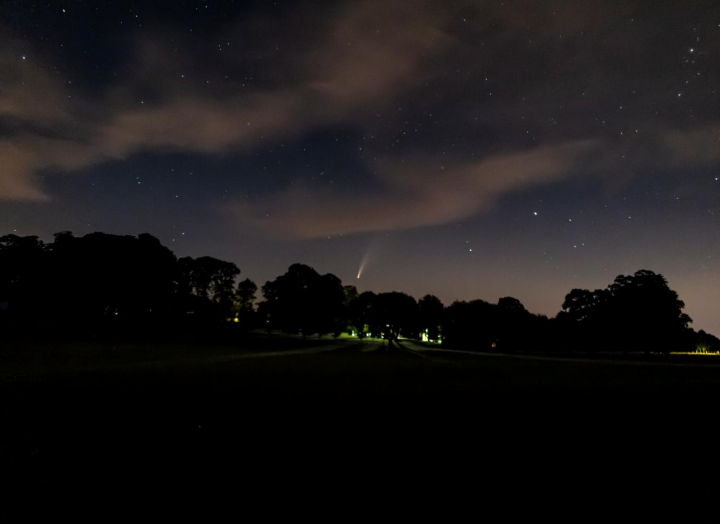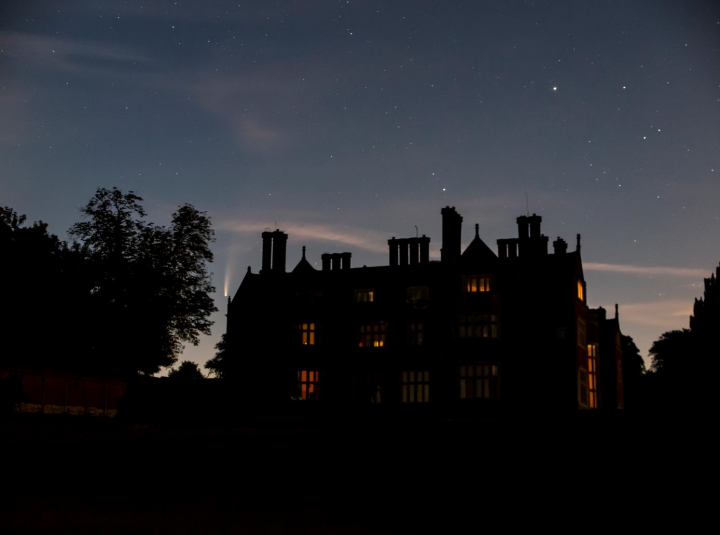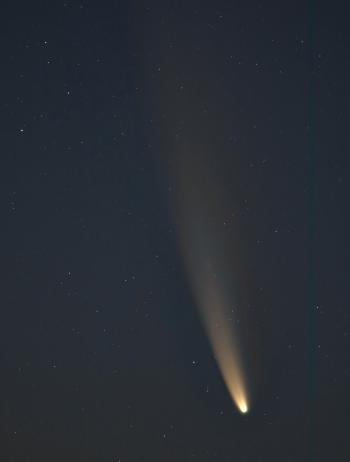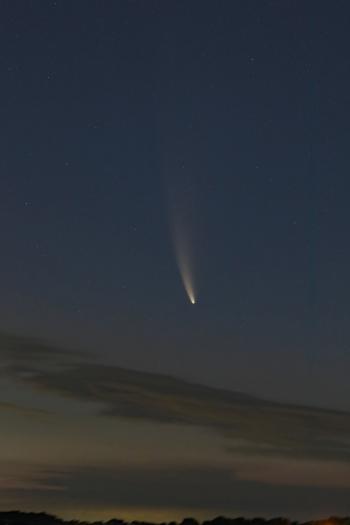Comet NEOWISE has switched to become a more easily-viewed evening comet. Don’t miss it! Here’s how to see Comet Neowise, including where and when to see the comet in the night sky.
This week, the clouds finally cleared to let us view comet NEOWISE. Wow! It’s the best we’ve seen in the past 24 years. Unless you live in the far south, you can easily find and observe this wonderful comet anywhere in the country.
Comet NEOWISE should be especially visible around the date of the new Moon (July 20) since moonshine won’t interfere with your viewing.
How to View Comet Neowise
Comet Neowise, named after the NASA equipment and camera that discovered it, has already achieved naked-eye visibility for those who live in dark-enough areas. Observers all across the country have reported sightings.
Starting Saturday, July 18, the optimum setting has now switched to the evening sky. It’s truly an easy observing project unless you’re in the midst of severe light pollution, like directly in a major city or you live just south of one.
- Best Time: 10:00 to 10:15 P.M., or about 90 minutes after your local sunset. See when the Sun rises in your location.
- Location: The comet is low – but not extremely low – in the northwest, just to the right of where the sun has set.
- Tip: At around 9:45 or 10 PM, start looking high-ish in the northwest and you’ll spot the Big Dipper. The comet is directly under the Big Dipper.
- Tool: Comet Neowise is easily seen with the naked eye, since it’s our best and brightest comet since Hale-Bopp in 1996. But binoculars really bring out the comet’s details. Any pair will do, although the extra light gathering ability of binoculars with larger objective lenses will come in handy. Binoculars always have two numbers, as in 8x30, 7x35, or 10x50. You want that second number to be at least 30.
But truly, any model is better than none at all. Of course, you don’t want to use such high power that the image shakes uselessly. Binoculars whose first number is greater than 10 will deliver a shaky image unless the instrument is “image stabilized” or else mounted on a tripod.
Make certain that your northwest view is not blocked by hills, trees, or houses. Clouds and bright streetlights will block it. Those living in rural areas have a big advantage.
So again:
- Look just over the horizon.
- Start when evening twilight is still bright and continue until it’s faded considerably.
- Use binoculars to sweep that region of sky.
This is definitely doable!

Pre-dawn photo of Comet Neowise on July 13, taken by Jordan Maendel in England. Mr. Maendel, a friend of the author, lives in New York’s Hudson Valley but is teaching this year at a private school in Great Britain.

Another pre-dawn photo taken before dawn Monday, July 13, by Jordan Maendel in England.
What to Expect When Viewing
Expect the comet to show a glorious tail that’s two or three times the size of the full Moon. In fact, from dark sites, and especially through binoculars, you might be able to detect two separate tails.
- The brighter one on the right is the dust tail, reflecting sunlight and appearing white.
- If you mount a camera on a tripod with a fast telephoto lens, your image may bring out the blue color of the fainter tail on the left, the plasma tail, caused by atoms being excited and glowing on their own.
Once you’ve detected the comet, you should have no problem seeing it. That said, you still need know where to look. Once you find it once, you’ll find it easily again.


Photo Credit: Dan Kaiser/Indiana Astronomical Society. This photo was taken on July 13, 2020 with a camera mounted on a Celestron telescope. The naked-eye view is very similar but fainter.
Yes—A Great Comet!
We’ve been disappointed with comets the past couple of decades. Comet ISON was touted as “the comet of the Century” after its discovery in September 2012. Some proclaimed that it would become brighter than the Full Moon. But as it approached the Sun, it was torn apart. By the time the Chile tour I led in early 2014 got our chance to observe it under ideal conditions, it was barely bright enough to see using our telescopes.
Comets do that. They break hearts. More recently, everyone had high hopes for comet Panstarrs, discovered in 2013 and believed to eventually brighten enough to match Venus. Instead, it, too, fell apart. As I reported, the recent Comet ATLAS and Comet Swan were also disappointing.
It’s been decades since we’ve had a great comet in the Northern Hemisphere.
But we’ve finally got a good one!
The Comet’s Future Behavior
Contrary to widespread misconception, comets never zoom across the sky. They hang stationary, slowly setting at the same speed as the Moon.
Expect the comet to be a bit higher-up each evening compared to the night before, although it will remain beneath the Big Dipper for the next week. That’s a good thing, because you’ll see it against darker skies with the twilight glow completely gone as the optimum viewing period shifts closer to 10:15 PM in many areas.
On the other hand, the comet is slowly fading in brightness even though it will be closest to Earth this coming Thursday, the 23rd. Worse, the Moon will return to throw unwelcome light to the western sky starting on the 24th and getting more troublesome each evening thereafter.
Struggling to See It?
Many readers across the country have spotted the comet, but many others have tried in vain. Hang in there!
I don’t want to play violin music here. Too many people are struggling with Covid anxieties, money emergencies, health issues and so on, to make the inability to easily see this fine comet sound like the end of the world.
But be aware, you’re now experiencing the woes that have plagued backyard astronomers since the 17th century. It inflicts challenges on every type of observation that revolves around a time-sensitive event. There might be the forecast of a great upcoming aurora display. Or an intense meteor shower. Or a total solar eclipse. Or, yes, a rare great comet expected to offer a peak display during a limited period of time.
The enemies are the same. Clouds, of course, will hide every type of celestial object. At great expense, a friend traveled the world to seven total solar eclipses, and was clouded out of four of them. Less well known is that thick haze can be just as obscuring if the object is not a brilliant one. You cannot view the Northern Lights through substantial haze. And since the majority of “shooting stars” are not bright, a very hazy night hides them too. The same applies to comet Neowise.
A bright Moon is bad as well. These nights surrounding the New Moon happen to be ideal for the comet. But an interfering Moon will be returning to the evening sky starting on Friday, July 24, and will only get fatter and brighter thereafter, until genuine interference is in place by the end of next weekend. So Comet Neowise is time-sensitive, beyond the fact that nobody knows how long it will retain its current glory.
Indeed, my wife and I tried to see it several times until we finally succeeded on July 17. That’s par for the course. So, hang in there. Happily, it’s easily found because it’s located a goodly distance directly below the familiar Big Dipper, about a quarter of the way up the northwestern sky, with the optimum time being 1 ½ hours after your local sunset.
Keep trying. You need clear or nearly-clear conditions, a reasonable dewpoint (measure of moisture in the air) of below 65° or so, and no local obstructions. For example, we saw folks along Cape Cod beach who were correctly looking northwest but were also gazing in the direction of Boston, not terribly far away. So there was major sky brightness around the comet’s location, which would have made it stand out far less dramatically. By contrast, my friend Matt Francis, whose comet image appear on this page, does a two-hour drive to Sedona each evening from his Prescott observatory, in order to nightly see the comet against a truly dark background.
Sky-fanatics are accustomed to the “nothing comes easy” slogan that the universe has always imposed on its devoted observers. Now, at least temporarily, you’ve perhaps become one of us. Welcome to this new kind of torture.
Bottom Line: Look for it as soon as you can, on the first clear evening. Thick haze may hide it, so optimally you want an evening with drier air and a cloudless patch in the northwest just as evening twilight fades away.
What exactly is a comet? See comet facts.
See the great comets and sky events in history.













